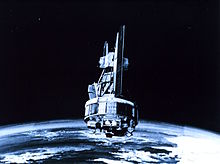Nimbus program
The Nimbus program was a second generation American weather satellite research program . It involved the launch of eight satellites (including one false launch). The Nimbus program was carried out in parallel to the TIROS program . The satellites were in sun-synchronous polar orbits .
Nimbus-7 was NASA's first satellite for global environmental monitoring. Mainly the earth's atmosphere, oceans, ocean-atmosphere exchange and the earth's heat balance were researched. The multispectral line scanner (6 channels) Coastal Zone Color Scanner (CZCS) , which worked until 1986, was specially designed for the observation of ocean color for the first time. The successors to this sensor are SeaWiFS and MODIS on Aqua .
Nimbus B1 crashed into the sea near the coast of California in 1968 after launching from Vandenberg AFB . The plutonium capsules of the two radioisotope generators of the satellite could be recovered undamaged from a relatively shallow water depth.
Satellite list
| satellite | COSPAR ID | Start date | rocket | Re-entry |
|---|---|---|---|---|
| Nimbus 1 | 1964-052A | August 28, 1964 | Thor Agena B | May 16, 1974 |
| Nimbus 2 | 1966-040A | May 15, 1966 | Thor Agena D. | 17th January 1969 |
| Nimbus B | NIMBS-B | May 18, 1968 | Thor Agena B | (False start) |
| Nimbus 3 | 1969-037A | April 14, 1969 | Thor Agena | January 22, 1972 |
| Nimbus 4 | 1970-025A | April 8, 1970 | Thor Agena | November 30, 1980 |
| Nimbus 5 | 1972-097A | December 11, 1972 | delta | |
| Nimbus 6 | 1975-052A | June 12, 1975 | delta | |
| Nimbus 7 | 1978-098A | October 24, 1978 | delta | 1994 |
All satellites were launched from Vandenberg Air Force Base .
Web links
- NSSDC: Nimbus Program (English)
- Nimbus satellites in the NSSDCA Master Catalog (English)
- Nimbus in the Encyclopedia Astronautica (English)
- Nimbus in the lexicon of remote sensing
- NASA Science Missions: Nimbus ( Memento from August 8, 2013 in the web archive archive.today ) (English)
Individual evidence
- ↑ Ricard R. Furlong and Earl J. Wahlquist: US space missions using radioisotope power systems (PDF; 1 MB) Nuclear News, April 1999
